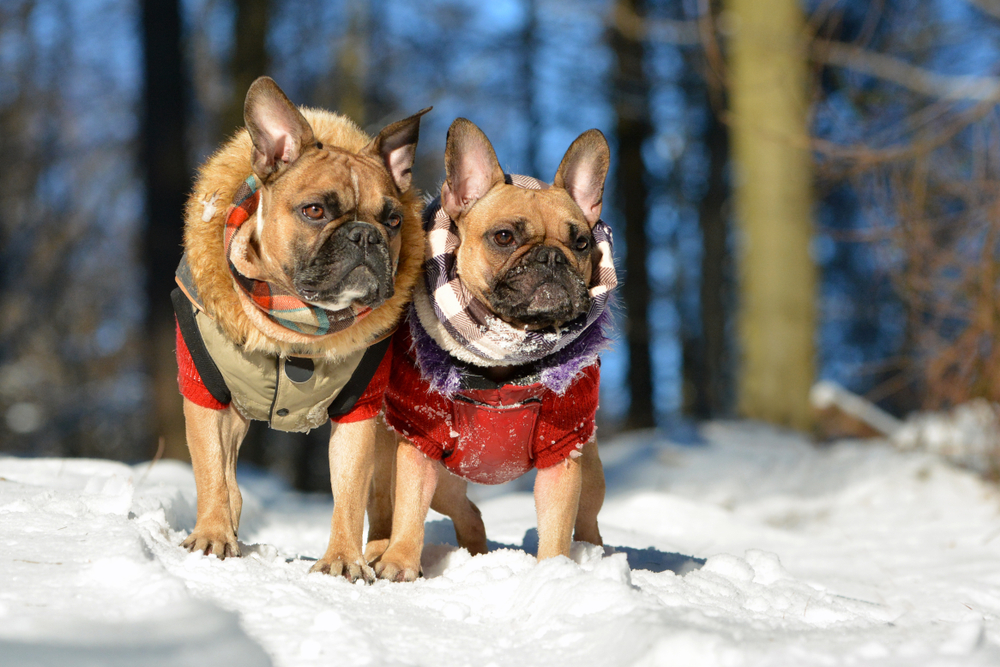
Pets in our Livermore community are accustomed to relatively warm winter conditions, so when a sudden temperature drop coincides with wet weather, your four-legged pet can be ill-equipped to handle the abrupt change. If you and your pet take a winter trip to a much colder area, your furry pal can have difficulty adjusting to bone-chilling windy and wet conditions. If your pet is going to be exposed to cold weather, read our Livermore Family Pet Hospital team’s cold safety ABCs to learn how to protect your pet from the wintry elements.
Always protect your pet from outdoor weather
Although your pet has a fur coat, they are susceptible to cold, wet weather. Short-haired pets’ fine fur provides little cold protection, while long-haired pets’ thick fur can trap moisture, chilling them to the bone. So, always outfit your furry pal appropriately for inclement weather, like you would yourself. Outfit your pet in a waterproof jacket to keep them warm when outdoors in snow, ice, sleet, and wind. In addition, dress them in properly fitted booties to protect their paws from ice, snow, and deicer.
Outfitting your pet in the proper gear is important to help ward off wet, chilly weather, but minimizing their severe weather exposure is also crucial. When walking with your pet, choose a route that is largely protected from the wind and snow by trees or buildings. Take a path that has little snowfall, or that has been shoveled, but avoid walking your pet on a surface that has been heavily salted, or treated with other ice-melting chemicals.
Be aware of hypothermia signs in pets
Learn to recognize your pet’s potential early-stage hypothermia signs to prevent a disastrous outcome. If you don’t take immediate action, your hypothermic pet can quickly succumb to cold, wet weather, becoming comatose and potentially dying. As they do when developing heatstroke, pets can begin experiencing adverse body-temperature-regulating signs long before the weather seems severe. In an attempt to keep their organs warm and functioning as mild and moderate hypothermia develop, your pet’s body shunts blood away from their extremities to their core. Your pet will also shiver to generate heat, which makes them clumsy and stiff. When outdoors with your pet, keep a close eye out for the following initial hypothermia signs:
- Cold paws, ears, and tail
- Shivering
- Muscle stiffness
- Lethargy
- Difficulty walking
- Pale gums
- Confusion
As hypothermia worsens, your pet will stop shivering because their muscle cells have run out of energy. Body processes begin to slow and shut down, leading to decreased and irregular heart and respiratory rates. As your pet struggles to pump enough oxygen through their body, they will become lethargic and unresponsive, slipping into a coma.
If your pet develops hypothermia and has a rectal temperature of less than 98 degrees, apply gentle warming methods. Bring them inside a warm building or car, and wrap them in warm towels or blankets. In addition, you can place warm water bottles next to your pet, provided you put a couple fabric layers between the bottles and their skin.
Cast a critical eye over household heating elements
Attempting to recreate a sizzling California summer, you may crank up the heat to keep your home toasty warm throughout the winter. However, fireplaces, space heaters, and heating pads can pose serious threats to your pet if they want to cozy up to them. To ensure your pet does not venture too close and burn their nose, paws, or fur, always prevent your furry pal from accessing these heating elements. In addition, keep in mind that these heat sources remain hot long after you turn them off or unplug them. So, keep unplugged electric heat sources out of your pet’s reach until they have sufficiently cooled, and keep the fireplace screen in place until you have shoveled out the ashes.
Don’t let your pet near antifreeze and deicing salt and chemicals
Chemicals meant to protect us from wintertime hazards can be toxic to pets. Antifreeze’s sweet flavor can tempt your pet to lap up a spill, but ingesting a small amount of this liquid can be fatal. Deicing salt and chemicals can irritate your pet’s paws, and if they lick the compound from their fur, they can experience vomiting, digestive upset, muscle weakness, neurologic issues, and fever. Pet-safe deicing alternatives are available, but you may not know where they have been used, so exercise caution when your pet has been on an unfamiliar sidewalk, patio, or driveway.
Examine your pet for health issues that can make cold weather less tolerable

Cold weather can aggravate certain pet-health conditions, and some medical problems can make your four-legged friend less tolerant of chilly temperatures. Ensure your furry pal is ready for winter weather by scheduling a wellness visit with your veterinarian, or talking with them about how you can keep your pet comfortable in unpleasant conditions, despite their arthritis, endocrine disorder, or skin issue.
If you will be traveling with your four-legged friend to a winter weather destination, ensure you know how to protect them from brutal conditions such as snow, ice, and bone-chilling wind. Before you expose your pet to winter’s chill, schedule an appointment with our Livermore Family Pet Hospital team to learn additional tips on keeping your pet safe from the elements.

